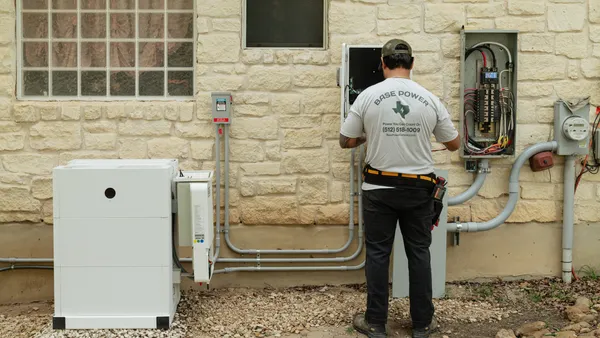Dive Brief:
- A combination of a climate change-induced heat storm, inadequate resource planning targets, as well as some aspects of the day-ahead energy market contributed to the rolling blackouts that occurred in California in August, state agencies said in a preliminary root cause analysis issued Tuesday.
-
The result was an extraordinary event, regulators acknowledged, "But it is our responsibility and intent to plan for such events, which are becoming increasingly common in a world rapidly being impacted by climate change."
-
California's key challenge is not having enough capacity to meet its net demand peak now, given weather extremes due to climate change, Seth Hilton, partner at Stoel Rives, said. "And so we need significantly increased procurement, potentially by 2021 — so, a very, very short timeline to procure additional capacity."
Dive Insight:
The California Independent System Operator (CAISO) directed utilities to initiate rolling outages for the first time in 20 years in the state on Aug. 14 and Aug. 15, in the midst of a record-breaking heatwave that had spread across the Western U.S.
Following the blackouts, the California Public Utilities Commission (CPUC), California Energy Commission (CEC) and CAISO wrote a letter to state Gov. Gavin Newsom, identifying multiple causes, including high demand, the unexpected loss of generation resources and the lack of available imports, that led to the blackouts.
The preliminary root cause analysis put out on Tuesday is "an intermediate milestone" in getting out a complete analysis, the agencies said in a press release. It didn't find a single cause that led to the blackouts — rather, the increased demand due to the heat wave played a role, as well as the fact that current resource planning processes have not kept pace with California's broader transition to a clean resource mix to ensure sufficient resources for the early evening hours.
California's resource adequacy systems were designed around the idea that having enough capacity at peak demand would ensure enough capacity for all hours of the day, since most resources could run continuously, the analysis noted. However, things are changing as more solar comes on to the grid.
"The single critical period of peak demand is giving way to multiple critical periods during the day," including the net demand peak, or peak of load net of solar and wind resources, which occurs later in the day, the report said.
The system operator, CPUC and CAISO identified the need to move quickly to prevent reliability issues in 2021 and after, including updating planning targets to account for extreme weather events as well as the changing resource mix. Regulators will need to both ensure that generation and energy storage projects that are currently being developed are completed on time, as well as fast-track regulatory processes to bring additional resources online by 2021, with a specific focus on demand response and flexibility. Additionally, regulators will need to ensure that CAISO's market practices are a proper reflection of actual supply and demand during "stressed operating conditions," according to the analysis.
Capacity issues in California could extend beyond 2021. The state has extended the deadlines to retire once-through-cooling plants by one to three years, after which they will be going offline, Hilton noted, and the Diablo Canyon nuclear plant is also scheduled to retire over 2024 and 2025.
"So our capacity needs are going to be exacerbated in the very near term," Hilton said.
On the other hand, the state was able to shrink its peak demand by up to 4,000 MW below day-ahead forecasts by spreading awareness about conservation measures on Aug. 17 through Aug. 19, according to the preliminary analysis
"That's a lot of capacity … so there's a real potential solution there in terms of demand response," Hilton said, adding that there needs to be an added focus on compensating or financially incentivizing individuals who voluntarily engage with demand response measures.
The August heat storm was a one-in-35-year event that is becoming more common with climate change, CPUC President Marybel Batjer said in a press release.
"We will absolutely adjust our planning, procurement, and market policies to meet these changing circumstances and ensure our energy future is clean, reliable, and affordable for all Californians," Batjer continues.
California utilities — including Pacific Gas & Electric (PG&E) — also raised concerns about the state's system in their integrated resource plans in September, with PG&E urging regulators to conduct an operational reliability assessment to make sure planned resources will ensure reliability.
PG&E is looking forward to working with the three agencies and others to address the actions outlined in the report to mitigate electricity shortages, utility spokesperson Lynsey Paulo said, adding that the utility continues to believe that the state must do more to ensure reliability of the electric grid, "particularly as the energy market in California continues to evolve and as we experience more frequent and severe hot weather because of climate change."















